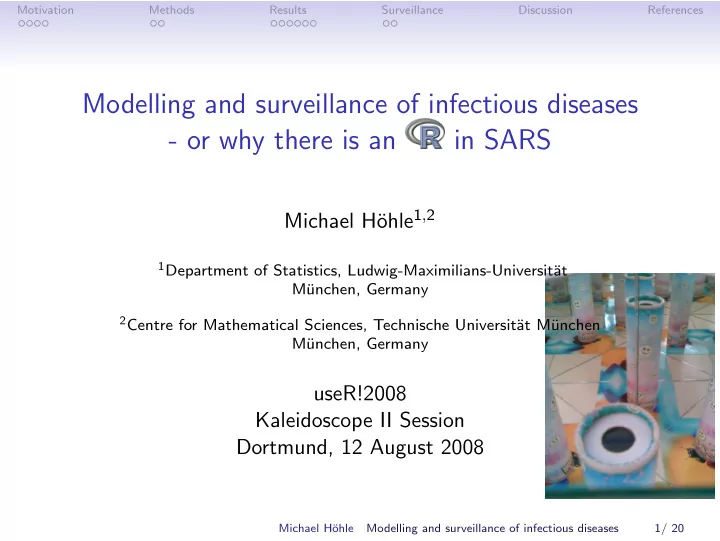

Motivation Methods Results Surveillance Discussion References Modelling and surveillance of infectious diseases - or why there is an in SARS ohle 1 , 2 Michael H¨ 1 Department of Statistics, Ludwig-Maximilians-Universit¨ at M¨ unchen, Germany 2 Centre for Mathematical Sciences, Technische Universit¨ at M¨ unchen M¨ unchen, Germany useR!2008 Kaleidoscope II Session Dortmund, 12 August 2008 Michael H¨ ohle Modelling and surveillance of infectious diseases 1/ 20
Motivation Methods Results Surveillance Discussion References Motivation How can R assist in understanding and controlling infectious diseases – be it in human, plant or veterinary epidemiology. Two R packages exist: RLadyBug contains a set of functions for the simulation and 1 parameter estimation in spatially heterogeneous SIR models. surveillance contains algorithms for the detection of 2 aberrations in time series of counts arising from routine public health surveillance This talk intends to give an overview of using R for especially (1) – deeper mathematical details are suspended to the lunch break > library("RLadyBug") Michael H¨ ohle Modelling and surveillance of infectious diseases 2/ 20
Motivation Methods Results Surveillance Discussion References Applications (1): SARS in Hong Kong 2003 Daily number of new cases of the severe acute respiratory syndrome (SARS) in Hong Kong (Anonymous, 2003) Epidemic curve created with package epitools (Aragon, 2007). 100 Healthcare worker Community 80 No. cases 60 40 20 0 15 21 27 5 11 17 23 29 4 9 15 21 27 3 8 14 20 Feb Feb Mar Mar Mar Mar Apr Apr Apr Apr May May Michael H¨ ohle Modelling and surveillance of infectious diseases 3/ 20
Motivation Methods Results Surveillance Discussion References Applications (2): CSF Transmission Experiment Experiment by Laevens et al. (1999) with classical swine fever (CSF) using S (0) = (5 , 5 , 6) and E = (0 , 1 , 0). Event history of each pig with inoculation as origin ( 1 , 1 ) ( 1 , 2 ) ( 1 , 3 ) 11:05 12:05 13:05 11:03 12:03 13:03 11:01 12:01 13:01 0 5 10 15 20 25 30 35 0 5 10 15 20 25 30 35 0 5 10 15 20 25 30 35 > data("laevens") > plot(laevens, type = individual ~ time | position) Michael H¨ ohle Modelling and surveillance of infectious diseases 4/ 20
Motivation Methods Results Surveillance Discussion References Applications (3) – CSF surveillance Classical swine fever (CSF) in Brandenburg (BB) and Mecklenburg-Western Pomerania (MP), Germany Total of 81 infected farms out of 3290 during 1993-2004 CSF in domestic pig farms in MPBB CSF among wild boars in MPBB 10 120 8 No. of cases No. of cases 80 6 4 40 2 0 0 1994 1998 2002 1994 1998 2002 Quarters Quarters Interest in investigating the connection between the CSF incidence among domestic pigs and wild boars Michael H¨ ohle Modelling and surveillance of infectious diseases 5/ 20
Motivation Methods Results Surveillance Discussion References Applications (4) - Spatial incidence of CSF in MPBB Domestic pigs in MPBB Wild boars in MPBB No case No case 1 case 1 case 2−5 cases 2−5 cases More than 5 cases 6−20 cases More than 20 cases Michael H¨ ohle Modelling and surveillance of infectious diseases 6/ 20
Motivation Methods Results Surveillance Discussion References Stochastic epidemic models (1) SEIR model: A closed population of n + m individuals divided into s usceptible, e xposed, i nfectious, and r ecovered S (0) = n , E (0) = m , I (0) = 0 and R (0) = 0 At time t , an individual j meets infectious at rate n + m � λ j ( t |H t ) = ✶ i ∈ Infectious( t ) · f ( i , j ) , i =1 where f ( · ) ≥ 0 is a function of the distance between i and j If a susceptible meets an infected, it becomes exposed Michael H¨ ohle Modelling and surveillance of infectious diseases 7/ 20
Motivation Methods Results Surveillance Discussion References Stochastic epidemic models (2) – Distance kernels 1 Homogeneous model: ∀ i , j : f ( i , j ) = β > 0 and hence λ j ( t |H t ) = β I ( t ) 2 Heterogeneous model: The population is made up of k units arranged on a grid in space. For j in unit u j : � λ j ( t |H t ) = β I u j ( t ) + β η I u ( t ) u ∈ N ( u j ) 3 Heterogeneous model, where individuals have locations in R 2 and f ( i , j ) is a function on the Euclidean distance dist( i , j ) Michael H¨ ohle Modelling and surveillance of infectious diseases 8/ 20
Motivation Methods Results Surveillance Discussion References SARS in Hong Kong 2003 Assuming a constant incubation time of 6.4 days and a constant recovery time of 34 days as suggested by the mean of the distributions in Donelly et al. (2003) we obtain > data("hksars") > print(m1 <- seir(hksars, hksars.opts.ml)) Calling LadyBug (monitor ladybug.system.out/err for progress)... ... Parameter Estimations: Parameter: beta 4.3984e-09 ... Basic reproduction number R 0 = R0(m1, hksars) = 1.0012. Michael H¨ ohle Modelling and surveillance of infectious diseases 9/ 20
Motivation Methods Results Surveillance Discussion References CSF Transmission Experiment (1) Exposure times are not observed, instead of imposing we assume T E ∼ G a ( δ E , γ E ) and T I ∼ G a ( δ I , γ I ) A Bayesian setting with MCMC is used for parameter inference > print(m2 <- seir(laevens, laevens.opts.mcmc)) An object of class LBInferenceMCMC Parameter Estimations (posterior mean from 2500 samples): Parameter: beta betaN gammaE deltaE gammaI deltaI 0.03706 0.02837 56.82000 9.37400 2.16200 0.25640 StandardErrors (posterior std.dev. from 2500 samples): beta betaN gammaE deltaE gammaI deltaI 0.018500 0.009481 45.510000 7.761000 0.738100 0.097760 Michael H¨ ohle Modelling and surveillance of infectious diseases 10/ 20
Recommend
More recommend